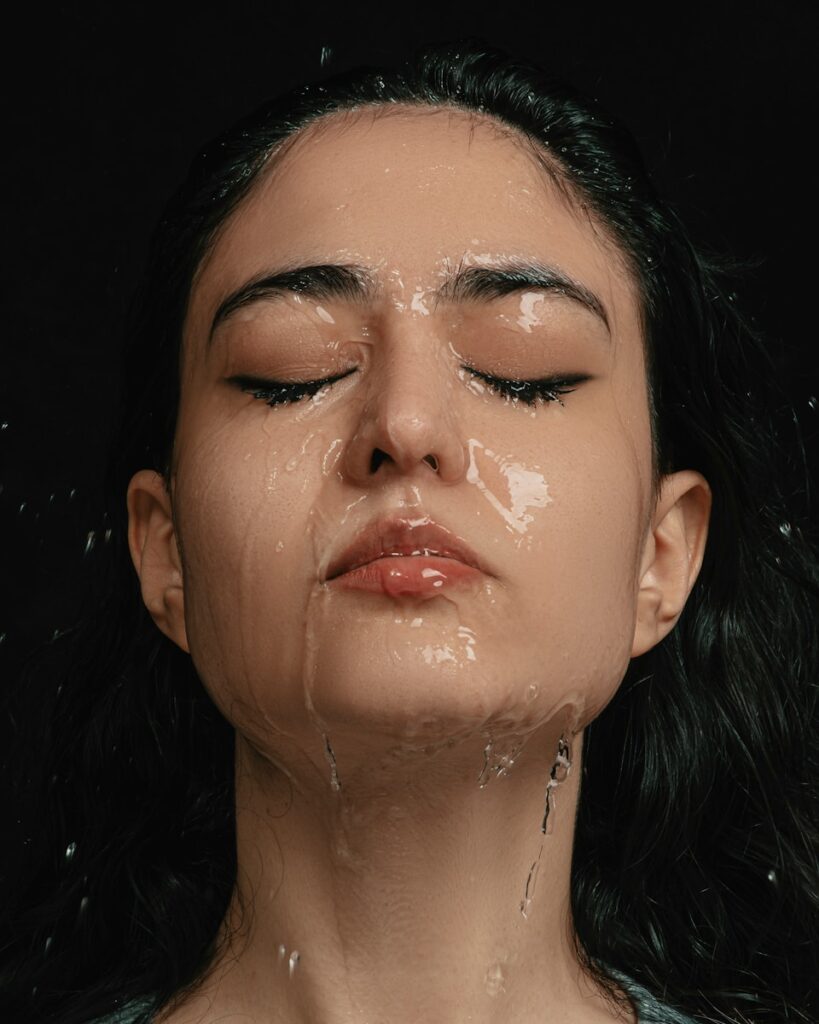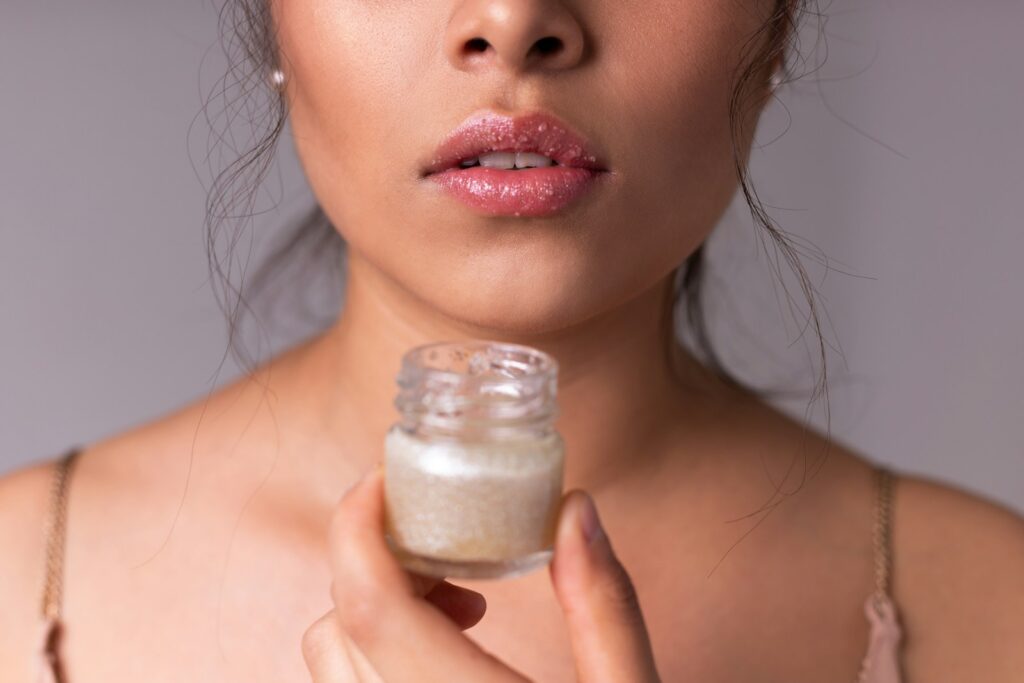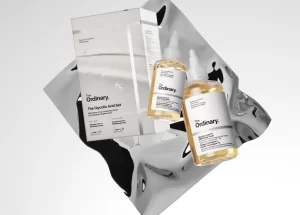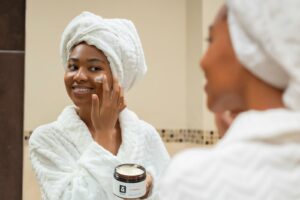Sensitive skin affects millions of people who deal with redness, burning, stinging, or itching when using certain products or facing environmental triggers. This type of skin reacts quickly to ingredients, weather changes, stress, and other factors that normal skin handles easily. 8 Tips to Soothe Sensitive Skin.
People with sensitive skin can find immediate relief by making simple changes to their daily skincare routine and choosing the right products. The key involves using gentle cleansers, lukewarm water, and moisturizers while avoiding harsh ingredients that cause flare-ups. These steps help strengthen the skin barrier and reduce irritation right away.
1) Use a fragrance-free, gentle cleanser to avoid irritation – 8 Tips to Soothe Sensitive Skin
Fragrance is one of the top causes of skin irritation for people with sensitive skin. Added fragrances contain chemicals that can trigger redness, burning, and breakouts.
Fragrance-free cleansers are the best choice for sensitive skin because they remove dirt and oil without harsh ingredients. These products focus on gentle, nourishing ingredients instead of scents.
When someone has sensitive skin, their skin barrier is already weakened. Regular cleansers with fragrances can make this worse by stripping away natural oils.
Gentle cleansers work differently than harsh ones. They clean the skin without removing the protective layer that keeps moisture in and irritants out.
Dermatologists recommend using mild, fragrance-free cleansers twice daily to remove dirt and oil. This routine helps maintain healthy skin without causing damage.
The best cleansers for sensitive skin contain ingredients like ceramides and glycerin. These components help repair and protect the skin barrier while cleaning.

Soap-free formulas are especially good for sensitive skin. Traditional soaps can be too alkaline and strip away natural oils that protect the skin.
Look for cleansers labeled as hypoallergenic and clinically tested on sensitive skin. These products have been specially made to reduce the risk of reactions.
Ingredients like niacinamide and panthenol can provide extra benefits. Niacinamide helps smooth skin texture and maintain the moisture barrier. Panthenol soothes and hydrates while protecting the skin.
Fragrance-free soaps provide gentle cleansing without stripping natural oils. They clean effectively while keeping the skin’s protective barrier intact.
People with sensitive skin should avoid cleansers with sulfates, alcohol, and dyes. These ingredients can cause dryness, redness, and stinging sensations.
The pH level of a cleanser matters for sensitive skin. Products with a pH close to the skin’s natural level work better than highly acidic or alkaline formulas.
Temperature also affects how well a cleanser works. Lukewarm water is best for washing sensitive skin because hot water can increase irritation.
When applying cleanser, gentle motions work better than scrubbing. Rubbing too hard can damage the skin and make sensitivity worse.
Face washes specifically designed for sensitive skin contain fewer potentially irritating ingredients. They focus on basic cleaning without unnecessary additives.
For body cleansing, fragrance-free body washes offer similar benefits. They clean larger areas of skin without causing widespread irritation.
The consistency of a cleanser can indicate how gentle it is. Creamy, lotion-like cleansers are often milder than foaming ones that create lots of bubbles.
Reading ingredient lists helps identify potential irritants. Shorter ingredient lists often mean fewer chances for reactions in sensitive skin.
People should patch test new cleansers before using them on their face or body. Apply a small amount to the inner arm and wait 24 hours to check for reactions.
Some cleansers contain added moisturizers to help maintain hydration. These can be especially helpful for people whose skin becomes dry after washing.
Oil-based cleansers can work well for sensitive skin that also tends to be dry. They remove makeup and dirt while adding moisture to the skin.
Micellar water offers another gentle option for sensitive skin. It uses tiny oil molecules to lift away dirt and makeup without harsh rubbing.
The frequency of cleansing matters as much as the product choice. Over-cleansing can irritate sensitive skin even with gentle products.
Morning and evening cleansing routines should use the same gentle approach. Consistency helps maintain the skin barrier and reduce irritation over time.
People with both sensitive and acne-prone skin need to be especially careful with cleanser choice. They need products that fight breakouts without increasing sensitivity.
Water quality can affect how well gentle cleansers work. Hard water with high mineral content can interfere with cleansing and leave residue on skin.
Storage of cleansers matters for maintaining their gentleness. Extreme temperatures can change the formula and make products more irritating.
The amount of cleanser used affects its gentleness. Using too much product can over-cleanse and irritate sensitive skin.
Rinsing thoroughly after cleansing removes all product residue that could cause irritation. Leftover cleanser on the skin can trigger reactions later.
Establishing a consistent routine with gentle products helps sensitive skin stay calm and healthy. Regular use of the right cleanser builds stronger skin over time. One of the 8 Tips to Soothe Sensitive Skin.
2) Rinse your face with lukewarm water, not hot, to prevent dryness.
Hot water feels relaxing on the skin, but it causes more harm than good. Hot water strips the skin of natural oils that protect against damage and dryness.

These natural oils sit between skin cells and act like a barrier. When hot water removes them, the skin loses its protection against pollution and irritation.
Lukewarm water is the best choice for washing faces. It cleans effectively without damaging the skin’s natural defenses.
People with sensitive skin notice the difference right away. Hot water can make their skin red, tight, and uncomfortable after washing.
Extreme heat can make wrinkles look worse by disrupting the skin’s natural structure. This happens because the protective oils get washed away.
Cold water is better than hot water, but lukewarm works best. Cold water does not clean as well and can shock sensitive skin.
Lukewarm water maintains the skin barrier’s integrity. This helps prevent dryness and irritation after cleansing.
The right water temperature feels neutral on the skin. It should not feel hot or cold when it touches the face.
People with dry skin benefit most from this change. Hot water makes their existing dryness worse and can cause flaking or tightness.
Keeping water temperature lower supports healthy skin. This simple switch prevents many common skin problems.
The skin produces oils for a reason. They keep moisture in and harmful things out.
When people use hot water regularly, they damage this natural system. The skin tries to make more oil to replace what was lost, which can cause problems.
Hot water disrupts the balance of natural oils that serve as protection. This leaves skin vulnerable to environmental damage.
Lukewarm water cleans just as well as hot water. It removes dirt, makeup, and excess oil without being harsh.
The cleaning power comes from the cleanser, not the water temperature. Hot water is not needed for good hygiene.
Sensitive skin reacts quickly to temperature changes. Hot water can cause immediate redness and burning sensations.
This reaction shows that the skin is being damaged. The heat opens up blood vessels and irritates nerve endings.
People notice their skin feels tighter after using hot water. This tightness is a sign that moisture has been lost.
If skin is already dry, hot water makes it worse. The extra dryness can lead to cracking and peeling.
Lukewarm water works for all skin types. Oily, dry, and combination skin all benefit from this gentler approach.
The change is easy to make but has big results. Most people notice softer, calmer skin within a few days.
Testing water temperature with the wrist helps find the right warmth. The water should feel comfortable, not hot or cold.
Some people worry that lukewarm water will not remove all the dirt and oil. This is not true when used with a good cleanser.
Gentle cleansing with lukewarm water is more effective than harsh scrubbing with hot water.
The skin heals better when it is not constantly irritated by hot water. This gives it time to repair and strengthen its natural barrier.
Many skin problems improve when people switch to lukewarm water. Redness, dryness, and irritation often decrease quickly.
This simple change costs nothing but makes a real difference. It is one of the easiest ways to treat sensitive skin better.
Hot showers and face washing often go together, but they should not. The face needs gentler treatment than the body.
Taking time to adjust the water temperature shows care for skin health. This small step prevents bigger problems later.
People who make this change often wish they had done it sooner. The improvement in skin comfort is noticeable right away.
Lukewarm water becomes a habit quickly. After a few weeks, hot water on the face feels obviously too harsh.
3) Apply a ceramide-rich moisturizer immediately after washing
Timing matters when applying moisturizer to sensitive skin. The best moment is right after washing, while skin is still slightly damp.
Water helps create a barrier that locks in moisture. When skin is damp, moisturizer can seal in that extra hydration.

Ceramides are lipids that naturally occur in the outer layer of skin. They help form a protective barrier that keeps moisture in and irritants out.
For sensitive skin, ceramides help strengthen the skin barrier and reduce irritation. This makes them ideal for people who experience redness, dryness, or discomfort.
Dermatologists often recommend applying moisturizer to clean, slightly damp skin immediately after bathing. This technique helps prevent water loss from the skin’s surface.
The application process is simple. After washing, gently pat skin dry with a clean towel. Leave skin slightly damp rather than completely dry.
Apply the ceramide moisturizer while skin still feels moist. This creates a seal that traps water beneath the moisturizer layer.
Ceramide-rich products are generally safe for all skin types. They work especially well for people with inflammatory skin conditions.
The ingredients in ceramide moisturizers help repair damaged skin barriers. When the barrier is stronger, skin becomes less reactive to environmental triggers.
For people with extremely dry or irritated skin, layering a ceramide moisturizer under a more occlusive product can provide extra protection. Facial oils or balms work well as the second layer.
Consistency is key for sensitive skin care. Those with dry skin, eczema, or itching should use ceramide-based moisturizers daily.
The best results come from making this a regular habit. Apply ceramide moisturizer every time after washing hands, face, or body.
Choose products specifically labeled as containing ceramides. Look for ceramide 1, ceramide 3, or ceramide 6-II on ingredient lists.
Some people worry about mixing ceramides with other skincare ingredients. Using a ceramide-rich moisturizer after applying retinol or vitamin C can soothe the skin.
The moisturizer acts as a buffer against potentially irritating active ingredients. It helps reduce redness and sensitivity that some people experience.
Temperature of the water used for washing also affects skin sensitivity. Lukewarm water is gentler than hot water, which can strip natural oils.
After washing with lukewarm water, the damp skin is in the perfect state to receive ceramide moisturizer. The combination helps restore what washing may have removed.
Different areas of the body may need different amounts of product. Hands and elbows often require more moisturizer than other areas.
Pay special attention to areas that feel tight or look red after washing. These spots typically benefit most from immediate moisturizer application.
The texture of ceramide moisturizers varies between brands and formulations. Creams tend to be richer than lotions and work better for very dry skin.
Sensitive skin often responds well to fragrance-free formulations. Many ceramide moisturizers are made without added scents or dyes.
People with sensitive skin should patch test new products before full application. Apply a small amount to the inner wrist and wait 24 hours.
If no irritation occurs during the patch test, the product is likely safe for regular use. Start with once-daily application and increase if needed.
The protective benefits of ceramides build over time with consistent use. Skin barrier function typically improves within a few weeks of regular application.
Some people notice immediate soothing effects, while others see gradual improvement. Both responses are normal for sensitive skin.
Storage of ceramide products affects their effectiveness. Keep moisturizers in cool, dry places away from direct sunlight.
Most ceramide moisturizers have a shelf life of 12 to 24 months when stored properly. Check expiration dates and replace products as needed.
The cost of ceramide moisturizers varies widely between brands. Drugstore options often work just as well as expensive department store versions.
Focus on the ingredient list rather than price when selecting products. Ceramides should appear in the first few ingredients for maximum benefit.
4) Avoid alcohol-based toners and harsh exfoliants
People with sensitive skin need to stay away from products that can damage their skin barrier. Two of the biggest culprits are alcohol-based toners and harsh scrubs.
Alcohol-based toners can enlarge pores and increase greasiness over time. They strip away the skin’s natural oils and leave it dry and irritated.
Common alcohols to avoid include ethanol, isopropyl alcohol, and denatured alcohol. These ingredients appear on product labels and can cause immediate stinging or burning.
Ethanol in toners can be quite drying for sensitive skin types. The higher the alcohol appears on the ingredient list, the stronger the concentration.
Instead of alcohol-based products, people should look for alcohol-free, soothing formulas. These gentler options clean the skin without causing irritation.
Physical scrubs pose another major problem for sensitive skin. Physical scrubs can cause microtears in delicate skin that lead to redness and inflammation.
Harsh exfoliants include products with rough particles like crushed walnut shells, salt, or sugar. These abrasive ingredients scratch the skin surface and make sensitivity worse.
People should avoid using brushes, washcloths, or other rough tools on sensitive skin. Even gentle pressure can cause irritation when the skin barrier is already compromised.
Alcohol-free toners offer significant advantages for sensitive skin by maintaining the natural moisture barrier. They reduce inflammation without the harsh drying effects.
Better alternatives include mild enzymatic exfoliants like papaya or pumpkin extract. These gentle options remove dead skin cells without physical scrubbing.
Enzyme exfoliants work by breaking down the bonds between dead skin cells. They provide effective results without the trauma of physical scrubs.
Chemical exfoliants like lactic acid can also work for some people with sensitive skin. They should start with very low concentrations and use them only once or twice per week.
When choosing a toner, people should look for ingredients like hyaluronic acid, ceramides, or aloe vera. These soothing components help repair and protect the skin barrier.
The key is to read ingredient labels carefully before buying any product. Many products marketed as gentle still contain drying alcohols or harsh ingredients.
People should patch test new products on a small area of skin before using them on their face. This helps identify potential reactions before they affect the entire complexion.
Gentle cleansing and moisturizing work better than harsh treatments for sensitive skin. The goal is to support the skin’s natural healing process rather than strip it further.
5) Use a broad-spectrum SPF 30 sunscreen daily to protect from UV damage.
Sensitive skin needs extra protection from ultraviolet rays that cause irritation and damage. Daily sunscreen use creates a barrier between delicate skin and harmful UV radiation.
Broad-spectrum sunscreen with SPF 30 or higher provides effective daily protection. This type blocks both UVA and UVB rays that penetrate the skin.
UVA rays cause premature aging and skin damage. UVB rays lead to sunburn and redness. Both types can trigger sensitivity flare-ups in reactive skin.
People with sensitive skin should choose mineral sunscreens when possible. These contain zinc oxide or titanium dioxide that sit on the skin’s surface. They reflect UV rays away from the skin instead of absorbing them.
Chemical sunscreens work by absorbing UV radiation into the skin. This process can cause irritation in people with sensitive or reactive skin types.
Daily sunscreen usage helps protect the skin barrier from damage. A strong skin barrier keeps moisture in and irritants out.
Sun damage weakens the skin barrier over time. This makes skin more prone to dryness, redness, and sensitivity reactions.
Apply sunscreen 15-30 minutes before going outside. This gives the product time to form a protective layer on the skin.
Use about one teaspoon of sunscreen for the face and neck area. Most people apply too little product to get full protection.
Reapply sunscreen every two hours when spending time outdoors. Sweat, water, and natural skin oils can reduce effectiveness over time.
Water-resistant formulas work best for extended outdoor activities. These stay on the skin longer when exposed to moisture.
Look for sunscreens labeled as non-comedogenic and fragrance-free. These formulas are less likely to clog pores or cause irritation.
Lightweight, non-greasy formulas absorb quickly into the skin. They work well under makeup and feel comfortable for daily wear.
Some sunscreens contain added ingredients like niacinamide or ceramides. These can provide extra soothing benefits for sensitive skin types.
Test new sunscreen products on a small skin patch first. Apply a small amount to the inner wrist and wait 24 hours to check for reactions.
Winter sun protection remains important even on cloudy days. UV rays penetrate through clouds and reflect off snow and ice.
Indoor workers still need daily sun protection near windows. UVA rays pass through glass and can cause skin damage over time.
People who spend time in cars should apply sunscreen to exposed areas. The side of the face and left arm get significant UV exposure while driving.
Higher SPF numbers provide slightly more protection but the difference is small. SPF 30 blocks about 97% of UVB rays while SPF 50 blocks 98%.
Sunscreen alone cannot fully protect sensitive skin. Combine it with protective clothing, hats, and seeking shade when possible.
Consistent daily use matters more than occasional heavy application. Regular protection prevents cumulative damage that worsens skin sensitivity.
Some medications increase sun sensitivity and require extra protection. Check with a healthcare provider about drug interactions that affect UV tolerance.
Physical barriers like wide-brimmed hats complement sunscreen protection. They provide additional coverage for the face, neck, and ears.
Sunglasses protect the delicate skin around the eyes from UV damage. This area is prone to premature aging and sensitivity reactions.
Choose sunscreen products from reputable brands that undergo safety testing. Look for products specifically formulated for sensitive or reactive skin types.
Store sunscreen in cool, dry places away from direct heat. Extreme temperatures can break down the active ingredients and reduce effectiveness.
Check expiration dates regularly and replace old products. Most sunscreens maintain effectiveness for about three years when stored properly.
Apply sunscreen as the last step in morning skincare routines. Let other products absorb first to prevent dilution of the sun protection.
Some tinted sunscreens provide light coverage while protecting the skin. These work well for people who want minimal makeup with built-in protection.
Stick formulations work well for reapplication over makeup. They provide targeted coverage without disturbing other products on the face.
Spray sunscreens offer convenient application for body areas. However, they require careful application to ensure even coverage without gaps.
Daily sunscreen use is critical for preventing long-term skin damage. It helps maintain healthier skin barrier function over time.
People with sensitive skin often see improvements in overall skin tolerance with consistent sun protection. Reduced UV exposure allows the skin to heal and strengthen its natural defenses.
6) Incorporate products with calming ingredients like niacinamide or oat extract
Choosing skincare products with gentle, soothing ingredients can make a significant difference for sensitive skin. Two standout ingredients that work well for most people are niacinamide and oat extract.
Niacinamide reduces redness and inflammation thanks to its anti-inflammatory properties. This water-soluble form of vitamin B3 helps calm irritated skin quickly.
The ingredient also strengthens the skin barrier over time. A stronger barrier means the skin becomes less reactive to environmental irritants and daily stressors.
Niacinamide minimizes pores by regulating oil production. This dual benefit helps sensitive skin look smoother while staying calm.
Most people can use niacinamide products daily without issues. It works well with other gentle ingredients and rarely causes reactions.
Oatmeal skin-care products should be on your radar to soothe your skin’s most irritable moments. Oat extract contains compounds called avenanthramides that naturally reduce inflammation.
These compounds help stop the itch-scratch cycle that often makes sensitive skin worse. Oat extract also forms a protective film on the skin surface.
The ingredient provides immediate relief for red, irritated areas. Many people notice their skin feels calmer within minutes of applying oat-based products.
Oat extract works especially well for people with eczema or dermatitis. It can be used multiple times per day when skin feels particularly sensitive.
Look for products that list niacinamide or oat extract high in the ingredient list. This means the product contains meaningful amounts of these calming ingredients.
Serums and moisturizers often contain higher concentrations than cleansers. The longer a product stays on the skin, the more time these ingredients have to work.
Start with products containing 2-5% niacinamide for sensitive skin. Higher concentrations can sometimes cause irritation in very reactive skin types.
For oat extract, colloidal oatmeal is the most studied form. This finely ground version dissolves easily in skincare formulas.
Some products combine both niacinamide and oat extract for enhanced calming effects. These combination products can be particularly effective for chronically irritated skin.
Always patch test new products before applying them to the entire face. Apply a small amount to the inner arm and wait 24 hours to check for reactions.
Many ingredients are safe for sensitive skin, but individual reactions can still occur. Testing helps prevent widespread irritation.
When introducing calming products, use them once every other day initially. Gradually increase frequency as the skin adjusts and shows signs of improvement.
These gentle ingredients work best as part of a consistent routine. Regular use helps build the skin’s tolerance and resilience over time.
Choose products with simple formulas when possible. Fewer ingredients mean less chance of encountering something that triggers sensitivity.
Fragrance-free versions of niacinamide and oat products are typically better for reactive skin. Added fragrances can counteract the calming benefits of these ingredients.
Both ingredients work well in morning and evening routines. They do not increase sun sensitivity like some other active ingredients do.
Layer these calming products under a gentle moisturizer for best results. The moisturizer helps seal in the beneficial ingredients and provides additional barrier protection.
With consistent use, most people see improvement in skin reactivity within 2-4 weeks. The skin often appears less red and feels more comfortable throughout the day.
7) Reduce stress through mindfulness or light exercise to improve skin resilience
Stress directly impacts sensitive skin by triggering inflammation and weakening the skin’s natural barrier. When cortisol levels rise, skin becomes more reactive and prone to irritation.
Mindfulness practices help reduce stress and create a calmer environment for skin healing. These techniques lower cortisol production and promote better blood flow to the skin.
Simple breathing exercises can make an immediate difference. The 4-7-8 technique involves inhaling for 4 seconds, holding for 7 seconds, and exhaling for 8 seconds.
This breathing pattern helps activate the body’s relaxation response. It reduces stress hormones that can trigger skin flare-ups and sensitivity.
Daily meditation sessions of just 10 minutes can lower cortisol levels significantly. Deep breathing exercises improve the skin’s resilience to environmental stressors and irritants.
Light exercise offers another effective way to manage stress for sensitive skin. Activities like walking, yoga, and tai chi help regulate stress hormones naturally.
Gentle movement like qigong and tai chi combines physical activity with mindful breathing. These practices improve circulation while reducing cortisol production.
Regular walking increases blood flow to the skin. Better circulation delivers more oxygen and nutrients to skin cells, supporting the healing process.
Yoga combines stretching with controlled breathing techniques. This combination helps release physical tension while calming the nervous system.
Swimming provides gentle, full-body exercise without high impact stress. The rhythmic movements and focus on breathing create a meditative effect.
Light stretching before bed can help reduce nighttime stress. Lower stress levels during sleep allow the skin more time to repair and regenerate.
Mindfulness needs regular practice to experience full benefits. Starting with just 5-10 minutes daily can begin to show improvements in skin comfort.
Progressive muscle relaxation involves tensing and releasing different muscle groups. This technique helps identify areas of physical stress that may contribute to skin sensitivity.
Guided meditation apps can help beginners establish a consistent practice. Many offer specific programs designed for stress reduction and better sleep.
Nature walks combine light exercise with exposure to calming environments. Being outdoors can naturally reduce stress hormones and improve mood.
Incorporating healthy habits like exercise supports both skin health and stress management. The key is finding activities that feel enjoyable rather than stressful.
Consistency matters more than intensity when using exercise for stress relief. Short, regular sessions work better than occasional long workouts for managing skin sensitivity.
People with sensitive skin should avoid high-intensity exercise that causes excessive sweating. Gentle activities prevent additional irritation while still providing stress relief benefits.
Cool-down periods after exercise help prevent overheating. Taking time to gradually return to normal body temperature protects sensitive skin from irritation.
Mindfulness meditation promotes a sense of calm and relaxation that directly benefits skin health. Regular practice helps build resilience against daily stressors.
Body scan meditations help people notice tension and stress before it affects their skin. This awareness allows for earlier intervention with relaxation techniques.
Breathing exercises can be done anywhere when stress levels begin to rise. Having these tools readily available helps prevent stress from triggering skin reactions.
The timing of stress-reduction activities can enhance their effectiveness for skin health. Morning meditation sets a calm tone for the day ahead.
Evening relaxation routines help the body prepare for restorative sleep. Quality sleep gives sensitive skin the best environment for overnight healing and repair.
Mindful self-care practices can lower cortisol levels and promote healthier skin. These techniques work by addressing the root cause of stress-related skin sensitivity.
Creating a dedicated space for relaxation activities can improve their effectiveness. Having a calm environment makes it easier to achieve the mental state needed for stress relief.
Combining mindfulness with gentle skincare routines creates a powerful stress-reduction practice. The act of caring for skin mindfully can become a form of meditation itself.
Regular stress management helps break the cycle of stress-induced skin flare-ups. As skin becomes less reactive, people often feel less stressed about their appearance.
8) Avoid switching skincare products frequently to prevent flare-ups
Switching skincare products too often can stress sensitive skin and trigger painful reactions. Each time someone introduces a new product, their skin needs time to adjust to different ingredients and formulations.
Frequent product changes disrupt the skin’s natural barrier function. This protective layer helps keep irritants out and moisture in.
When people constantly try new cleansers, serums, or moisturizers, they overwhelm their skin’s ability to adapt. The skin becomes confused and reactive instead of calm and balanced.
Avoiding frequently switching up products helps prevent long-term damage to the skin barrier. This practice allows the skin to maintain its stability and reduce flare-up risks.
Most skincare products require four to six weeks to show their full effects. Switching before this time period doesn’t give products a fair chance to work properly.
Sensitive skin types need extra patience when testing new products. Their skin reacts more strongly to changes compared to normal skin types.
Product switching can cause several unwanted reactions. These include redness, burning, itching, dryness, and breakouts that weren’t present before.
Each new product brings different preservatives, fragrances, and active ingredients. Sensitive skin struggles to process these various chemical combinations quickly.
The skin’s pH level can shift when products change frequently. This disruption affects the skin’s natural protective acid mantle.
When someone finds products that work well for their sensitive skin, consistency becomes key. Sticking with proven formulas helps maintain skin health over time.
Emergency situations may require temporary product changes. However, returning to the regular routine as soon as possible helps restore skin balance.
Complex skincare routines with multiple new products can cause more harm than benefit for sensitive skin types. Simple, consistent routines work better for reactive skin.
Social media trends often encourage trying many new products quickly. This approach can backfire for people with sensitive skin conditions.
Patch testing becomes even more important for those with sensitive skin. Testing one new product at a time helps identify specific triggers.
The 24 to 48-hour patch test period helps reveal potential reactions. This simple step can prevent widespread facial irritation from occurring.
When introducing a new product, people should wait at least two weeks before adding another item. This timeline allows proper assessment of individual product effects.
Seasonal changes may tempt people to switch their entire skincare routine. However, gradual transitions work better for sensitive skin types.
Temperature and humidity changes affect sensitive skin naturally. Adding new products during these times increases the risk of reactions.
Some people mistake normal adjustment periods for product failure. Initial mild reactions often resolve as the skin adapts to new formulations.
Professional guidance helps people make smart product choices. Dermatologists can recommend suitable alternatives when current products stop working effectively.
Keeping a skincare diary helps track which products cause problems. This record becomes valuable when selecting future products or identifying triggers.
Writing down reaction symptoms, timing, and product names creates useful patterns. This information helps healthcare providers make better recommendations.
Brand loyalty often benefits people with sensitive skin. Companies that work well for someone’s skin type usually continue producing compatible products.
Ingredient lists should remain fairly consistent when switching products within the same category. This approach reduces the risk of introducing problematic new components.
Generic or store-brand versions of successful products may offer cost savings. However, inactive ingredients can differ and potentially cause new sensitivities.
Travel-sized versions allow safe testing of new products. This approach limits waste if reactions occur during the trial period.
Gift skincare products should be introduced carefully, even from trusted brands. The recipient’s skin may not react the same way as the giver’s skin.
Professional treatments or prescription changes may require temporary routine adjustments. However, returning to the base routine helps maintain long-term skin health.
Age-related skin changes happen gradually over years. Sudden routine overhauls aren’t necessary and may cause unnecessary irritation for sensitive skin types.
Product expiration dates matter more for sensitive skin users. Expired products can harbor bacteria or develop irritating chemical changes.
Storage conditions affect product stability and safety. Heat, light, and air exposure can alter formulations and increase sensitivity risks.
When discontinuing products, gradual reduction works better than sudden stops. This approach helps the skin adjust without experiencing rebound reactions.
Building a small collection of trusted backup products provides security. Having alternatives ready prevents panic-driven poor product choices during flare-ups.
Quality over quantity should guide sensitive skin product selections. A few reliable products work better than cabinets full of untested options.
Consistent morning and evening routines help sensitive skin maintain its natural rhythm. Disrupting these patterns can trigger unexpected reactions even with familiar products.
Understanding Sensitive Skin
Sensitive skin reacts quickly to products, weather, and daily activities that don’t bother most people. Knowing what triggers these reactions and how sensitive skin works differently helps people choose better care routines.
Common Triggers and How to Recognize Them
Sensitive skin often reacts to products people use every day. The most common triggers include fragrances, alcohol-based products, harsh soaps, and extreme temperatures.
Product Triggers:
- Perfumes and scented lotions
- Alcohol-based toners
- Harsh scrubs and exfoliants
- Retinoids and strong acids
Environmental Triggers:
- Hot water during showers
- Cold, dry air
- Sun exposure
- Wind and pollution
People with sensitive skin notice reactions within minutes or hours. Their skin may turn red, feel tight, or start burning. Some experience small bumps or patches of dry, flaky skin.
Stress can also trigger sensitive skin flare-ups. When stress levels rise, the skin barrier weakens and becomes more reactive to normal triggers.
Recognition happens through paying attention to timing. If skin reacts after using a new product or going outside, that item or activity is likely a trigger.
How Sensitive Skin Differs From Other Skin Types
Sensitive skin has a weaker protective barrier compared to normal skin types. This barrier normally keeps moisture in and irritants out. When it’s damaged, the skin loses water faster and lets harmful substances penetrate deeper.
Normal Skin vs Sensitive Skin:
| Normal Skin | Sensitive Skin |
|---|---|
| Thick, strong barrier | Thin, weak barrier |
| Holds moisture well | Loses water quickly |
| Rarely reacts to products | Reacts to many products |
| Recovers fast from irritation | Takes longer to heal |
The nerve endings in sensitive skin sit closer to the surface. This makes people feel stinging, burning, or itching more easily than those with normal skin.
Sensitive skin needs barrier-repairing products that contain ingredients like ceramides and niacinamide. Regular skin types can handle stronger active ingredients without problems.
Unlike oily or dry skin types that focus on oil production, sensitive skin care centers on reducing irritation and strengthening the protective barrier.
Creating a Supportive Skincare Environment
The fabrics that touch your skin and the air you breathe at home can trigger sensitivity reactions. Small changes to your clothing choices and indoor climate help reduce daily irritation.
Choosing the Right Fabrics and Textiles
Cotton and bamboo fabrics work best for sensitive skin. These natural materials let air flow through and don’t trap heat or moisture against the body.
Synthetic fabrics like polyester and nylon can cause problems. They hold sweat and create friction that leads to rashes and bumps.
Fabric softeners and harsh detergents leave chemical residue on clothes. This residue sits against the skin all day and causes reactions. People with sensitive skin should use gentle, fragrance-free detergents instead.
Bedding matters too. Cotton or bamboo sheets feel softer than synthetic blends. Washing pillowcases twice per week removes oils and bacteria that can clog pores.
New clothes should be washed before wearing. The chemicals used in manufacturing and shipping can irritate delicate skin on first contact.
Optimizing Your Home Climate
Humidity levels between 40-50% prevent skin from drying out. Dry air pulls moisture from the skin and makes sensitivity worse.
A humidifier adds moisture to the air during winter months. This simple device helps maintain the skin’s natural barrier function.
Hot showers and baths strip natural oils from the skin. Water temperature should feel warm, not hot. Limiting bath time to 10 minutes also prevents over-drying.
Air conditioning and heating systems can make indoor air too dry. Running a humidifier in bedrooms at night helps skin recover while sleeping.
Dust and allergens in the home trigger skin reactions. Regular vacuuming and washing bedding in hot water reduces these irritants.








